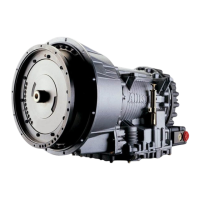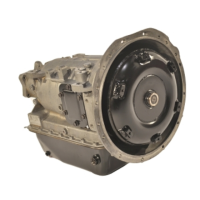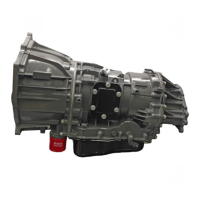Shifts from N (Neutral)-to-D (Drive) or N (Neutral)-to-R (Reverse) are also
inhibited when the TCM/ECU has been programmed (by input/output function) to
detect that auxiliary equipment is in operation and the shift should not be allowed.
When directional change shifts are inhibited, the TCM/ECU will put the
transmission in N (Neutral) and the digital display, if present, will flash the letter
of the range selected (D or R). To reselect D (Drive) or R (Reverse) when engine
throttle, engine speed, and transmission output speed are below the calibration
value:
• Pushbutton selector—Press the desired pushbutton again.
• Lever selector—Move the lever to N (Neutral) and then to the desired
range.
When a direction change shift is requested and engine throttle, engine speed, and
transmission output speed drop below the calibration value during the calibration
time interval, the shift to D (Drive) or R (Reverse) will occur.
For example, if the transmission output speed was just above the calibration limit
when R (Reverse) was selected, but dropped below the limit during the next three
seconds, the shift to R (Reverse) would occur (assuming the engine was at idle
and the throttle was closed).
USING THE ENGINE TO SLOW THE VEHICLE
WARNING: To avoid loss of control, use a combination of
downshifting, braking, and other retarding devices. Downshifting to a
lower transmission range increases engine braking and can help you
maintain control. The transmission has a feature to prevent automatic
upshifting above the lower range selected. However, during downhill
operation, if engine governed speed is exceeded in the lower range, the
transmission will upshift to the next higher range to prevent engine
damage. This will reduce engine braking and could cause a loss of
control. Apply the vehicle brakes or other retarding device to prevent
exceeding engine governed speed in the lower range selected.
Engine braking provides good speed control for going down grades. When the
vehicle is heavily loaded, or the grade is steep, it may be desirable to preselect a
lower range before reaching the grade. If engine-governed speed is exceeded, the
transmission will upshift automatically to the next range.
To use the engine as a braking force, select the next lower range. If the vehicle is
exceeding the maximum speed for this range, use the service brakes and/or
retarder to slow the vehicle. When a lower speed is reached, the TCM/ECU will
automatically downshift the transmission.
37

